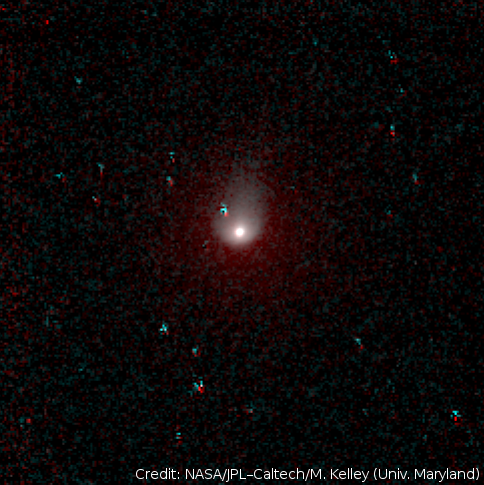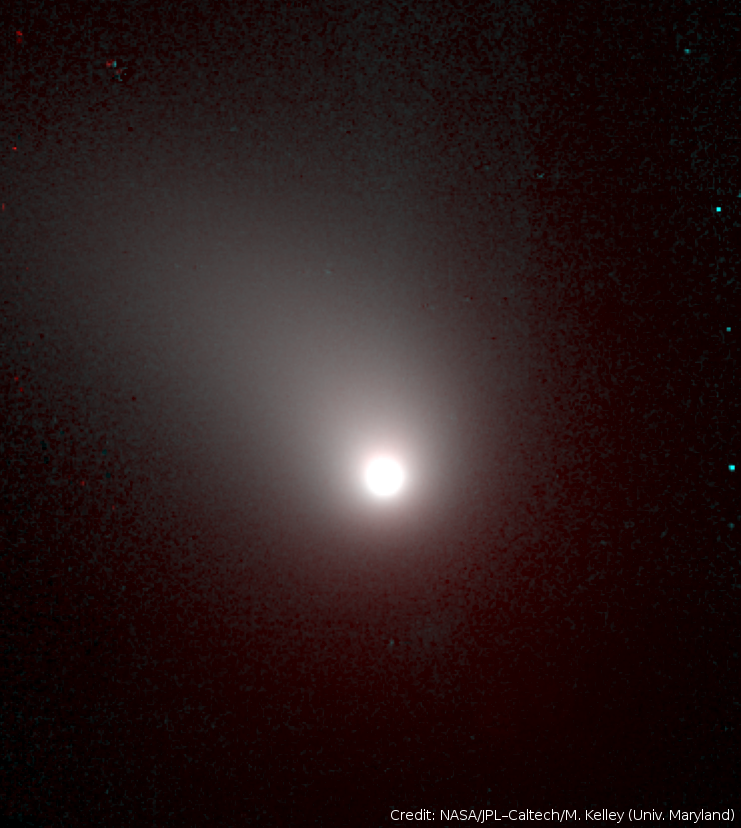Comet C/2013 US10 (Catalina)
December 5, 2015
Comet Catalina is bright and ready for your small telescopes. I present a toy model of its orbit and some pictures from the Spitzer Space Telescope.
Comet C/2013 US10 (Catalina) was discovered by the Catalina Sky Survey on Halloween in 2013. At that time, the comet was 8 AU from the Sun (1 AU = the distance between the Earth and Sun), or just inside the orbit of Saturn. Distant comet discoveries are exciting for astronomers. First, this usually indicates it is an intrinsically bright comet. When such comets enter the inner-solar system, they usually become one of best comets of that year. Comets C/2011 L4 (PanSTARRS), C/2012 K1 (PanSTARRS), C/2012 S1 (ISON) are recent examples, discovered at 8, 9, and 6 AU, respectively. Second, distant discoveries give astronomers the opportunity to follow a comet for a long period of time. This allows us to study how the comet evolves and also gives us time to prepare for detailed observations when it is bright. We have been waiting 2 years for comet Catalina, and now it has arrived.
See comet Catalina
For star charts and other info on comet Catalina, find your favorite local amateur astronomy club or check out Sky & Telescope.
Comet Catalina's Orbit
Comet Catalina is a member of the Oort cloud, a tenuous swarm of icy bodies surrounding the Sun. The Oort cloud is huge: a whole light year across! Comets were placed there four billion years ago, during a chaotic time in our history. The giant planets had scattered icy bodies all over the Solar System. Some where placed on such large orbits, they felt the gravitational pull of the Galaxy and nearby stars. This pull stabilized their orbits and created the Oort cloud. Today, Galactic perturbations occasionally throw comets back into the inner Solar System, and this is exactly what happened to comet Catalina a million or so years ago.
When comets first enter the inner-solar system from the Oort cloud, they are very loosely bound to the Sun. With the right gravitational kick from Jupiter, these comets can be entirely ejected from the Solar System, destined to wander interstellar space. Or, the comet could be pulled in even deeper into the Sun's gravitational well and placed on a smaller orbit. The smaller orbits are "only" tens or hundreds of thousands of years long, compared to the original million-year long orbits. According to the calculations of Syuichi Nakano, and considering the large effect Jupiter can have on a comet's orbit, it looks like comet Catalina is on its first passage into the inner solar system.
Images with the Spitzer Space Telescope
As part of a program to study the orbital evolution of comets, we have been imaging comet Catalina for the past 10 months with the Spitzer Space Telescope. With Spitzer, we can image the comet's dust and gas. Below are two samples of our data set.

C/2013 US10 (Catalina) at 4.0 au
NASA/JPL-Caltech/M. Kelley (University of Maryland) (CC BY 4.0).

C/2013 US10 (Catalina) at 1.6 au
NASA/JPL-Caltech/M. Kelley (University of Maryland) (CC BY 4.0).
These Spitzer IRAC images of comet Catalina were taken in February (left) and August (right) of this year, when the comet was at 4.0 and 1.6 AU from the Sun. In these false-color combinations of two images, emission from the comet's dust coma and tail shows up as blue-white, and emission from the comet's gas coma (here, carbon dioxide and carbon monoxide) as red. The telescope was tracking the comet during these observations, so stars show up as cyan- and red-colored artifacts.